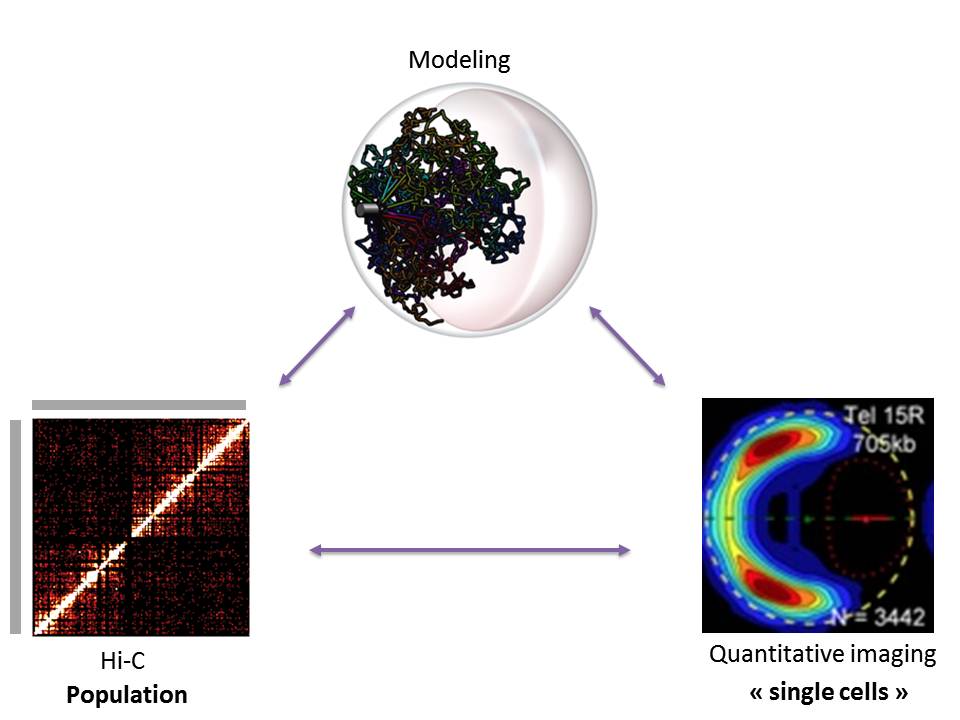Conference
______________________________________________
Thursday 27 March
14h00 – 15h30
Université de Lorraine – Faculté des Sciences, Vandoeuvre – amphitheatre 7
“Insights on the diversity of chromosomes organization in eukaryote and prokaryote microorganisms”
Resumé :
Capture of chromosome conformation experiments reveal the average three-dimensional organization of chromosomes in eukaryotes and prokaryotes. While mammals have been extensively studied in this regard for the past couple of years, little is known about the diversity of microorganisms chromosome organization. In this presentation, the genomic organization of a variety of microorganisms will be presented and discussed, both prokaryotes and eukaryotes. In addition, several “alternative” applications of the technique will be presented. For instance, chromosomes in the nuclear space exhibit with unique three-dimensional signatures that can be used to solve their sequences. Using the contact frequencies between all genome segments as indicators of spatial proximity, we provide the theoretical background and the experimental demonstration validating this approach by solving the structure of mutant and uncompleted genomes. Upon initialization with a set of contigs, the algorithm will reorganize, split, or duplicate DNA regions, as well as provide an estimation of the size of the gaps that lay in-between. This technique, based on Bayesian inference, allows us to estimate the posterior probability of an assembly by estimating its likelihood given the data and prior knowledge sourced from polymer physics. We show that this approach can be useful for deciphering structural rearrangements, among other interesting applications that will be introduced.
______________________________________________________________________________
Romain Koszul
Department of Genomes and Genetics
Institut Pasteur / CNRS UMR 3525
25-28, rue du Docteur Roux
75724 Paris Cedex 15, France
Romain Koszul is a group leader at Institut Pasteur and a research fellow at the French national research organization CNRS. He holds a MSc in Microbiology and Genetics from University of Paris 6, and a MSc in Engineering from AgroParisTech. In 2001, after a brief experience in industry (IBM), he started a PhD in Genetics with Pr. Bernard Dujon and Dr. Gilles Fischer. His work revealed the spontaneous occurrence and stability of large DNA segmental duplication in the yeast genome, while unveiling a likely mechanism of formation through non-homologous, micro-homology mediated strand invasion events. Interested in the influence of chromosome physical properties, dynamics and organization on the genome stability, he joined the laboratory of Pr. Nancy Kleckner at Harvard University as a postdoc in 2005. There, he investigated several aspects of chromosomal dynamics, ranging from genomic instability to directed motion mediated through cytoskeleton actin during meiosis. He also started collaborative approaches with physicists and mathematicians that led him to develop his own interdisciplinary projects in Europe, where he moved back in 2009 with a CNRS position.
In 2010, he was appointed as a group leader at Institut Pasteur within the Genomes and Genetics department and with funding from the European Research Council. Its research aims at gaining a better understanding of the influence of chromosome organization onto the genetics and physical controls of several DNA-related biological processes. To do so, the group uses a combination of genome-wide and single-cell technologies, and in vitro and in vivo approaches. All current projects involve the use of genetics, genomic derivatives of chromosome conformation capture technique (3C), high-resolution gene mapping and chromatin dynamics quantitative analysis. They also involve physicists and mathematicians that aim both at improving imaging and data analysis, as well as at contributing to theoretical modeling studies. The work is mostly done using fungi from the phylum Ascomycota and principally on budding yeast Saccharomyces cerevisiae. However, the number of unicellular organisms studied in the team has increased and now includes unicellular species ranging from bacterial to Amoeba.



